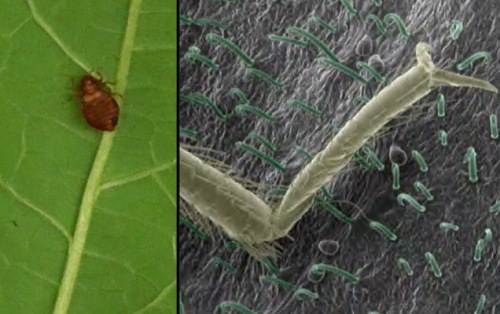SLEEP TIGHT–BED BUGS HOOKED ON BEAN LEAVES
 Bedbug on leaf and enlargement of bedbug impaled by leaf Photo credit Megan Szyndler and Catherine Loudon, University of California-Irvine
Bedbug on leaf and enlargement of bedbug impaled by leaf Photo credit Megan Szyndler and Catherine Loudon, University of California-Irvine
Though bedbugs don’t transmit diseases, bedbugs’ bites cause burning, itching, swelling as well as psychological distress. The parasite’s ability to breed rapidly, hide anywhere and to “hitchhike” to new places makes them difficult to control and detect.
They’re extreme survivors, being able to live for up to a year without feeding on blood.
Current extinction methods—heating, freezing, pesticides and vacuuming–are costly and unreliable.
Rather than relying on professionals, many persons employ dangerous and ineffective assaults on the bugs, such as spraying themselves and their surroundings with nonapproved insecticides.
Here’s the kicker–no pesticide can touch a bedbug because they’re programmed to detoxify all pesticides and prevent them from penetrating.
Given the above control problems, researchers at the University of California-Irvine and the University of Kentucky investigated a Balkan folk remedy that calls for strewing kidney bean leaves on the floor area surrounding beds and then burning the leaves the next day.
Historically, when philosopher John Locke traveled across Europe in the 17th Century, he carried a supply of the leaves with him for protection. So did the Royal Austro-Hungarian Army.
What the team of scientists discovered is that the Serbs, Bulgarians and others living in southeast Europe indeed had an effective cure for the bedbug problem: Within seconds of stepping on the bean leaf, bedbugs are impaled and trapped by microscopic hooked hairs known as trichomes.
Effective as they are, the leaves dry out quickly and can’t be placed in areas other than the floor.
So the researchers fabricated synthetic materials that temporarily snag the bedbugs but as of yet, don’t do away with the bugs as effectively as do the natural leaves.
Lead author of the study, Catherine Loudon of UC Irvine, says the failure suggests the crucial mechanics of the trichomes still need to be discovered.
She adds, “Nature is a hard act to follow, but the benefits could be enormous. Imagine if every bedbug inadvertently brought into a dwelling was captured before it had a chance to bite and multiply.”
Sources: Smart Planet Daily, April 10, 2013 UCIrvine News, April 9, 2013 Sierra Club, Northeast Ohio Group, April 24, 2013 Study published in Journal of the Royal Society Interface, April 9, 2013 Study funded by the National Science Foundation.
